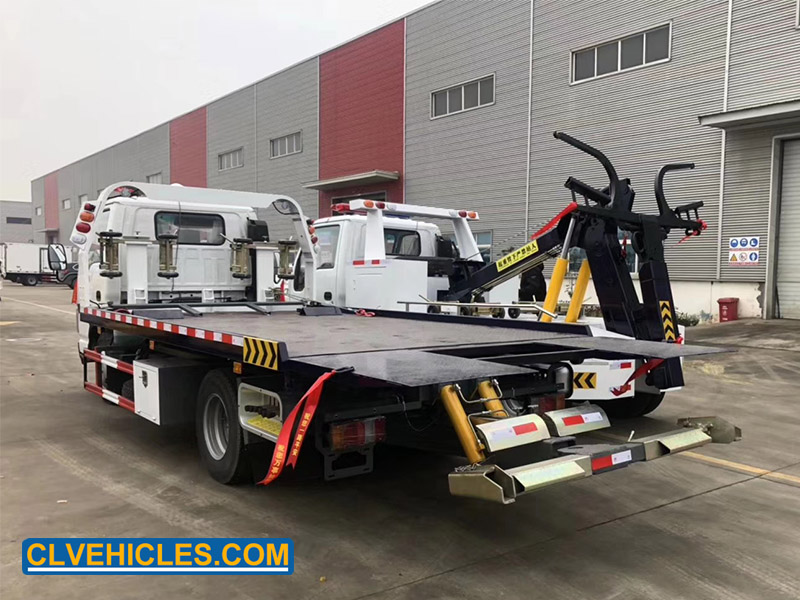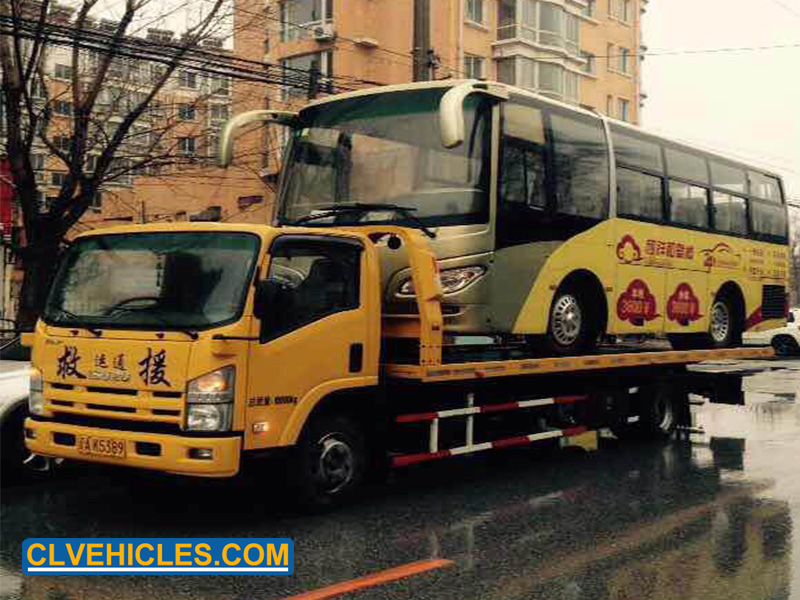The wrecker truck, also known as the flatbed wrecker truck, is characterized by the ability to carry one car on the flatbed, the towing mechanism can lift the front wheel of another car, and the rear wheel can land on the ground for simultaneous wrecking and towing.
CLVEHICLES.COM came to explain to everyone in detail: the detailed operation steps of flatbed wrecker and loading a car on it.
1. First, the platform of the wrecker needs to be lifted and moved back so that it is in a straight line with the towed vehicle, and then slowly tilt the platform to the ground. If the ground is not level, a transition plate needs to be placed at the contact between the platform and the ground. Avoid too much effort when towing the vehicle at a too large angle.
2. Disengage the clutch of the wrecker winch, pull out the steel rope to hang the J-hook on the towing shackle of the wrecked vehicle, and then combine the clutch of the wrecker winch. Note: When pulling out the steel rope, the remaining number of steel rope loops shall not be less than 3 laps.
3. Put the gear of the wrecked vehicle to neutral and release the parking brake of the wrecked vehicle.
4. Control the winch lever of the flatbed tow wrecker, pull the towed vehicle onto the platform, and control the J-hook on the steel wire rope. Keep the distance from the winch greater than 0.4m.
Notice! ! When the winch is under load, do not disengage the manual control clutch of the winch! ! This will damage the winch.
Notice! ! When using a winch to tow an accident vehicle, especially a car with a lower chassis, be very careful not to damage the front part of the trailer, so as not to cause unnecessary trouble.
5. After the wrecked vehicle has been towed to the upper plate, tie the rear tire of the towed vehicle with the fastening strap provided with the vehicle, and pull the rigid belt diagonally to the rear sides to make it hook on the two sides. On the side of the plate pull ring.
Note: If the sturdy safety tab is broken, the fastening strap should be wrapped around the sturdy part of the car. For fastening straps that cannot be manually locked, the winch can be manipulated by the winch lever to move the loading vehicle forward a bit, so that the fastened seat belts can be properly tightened.
6. Flat-type wreckers, when using fastened safety straps to fix the faulty car on the flatbed, four straps must be locked on the wheels or the body respectively.
7. The strap ratchet must be in the closed state when locked.
Notice! ! Nylon bandages will become loose if they are tightened for a long time. You should check the bandage tightness regularly during operation, especially when the road conditions are bad or there are more sudden brakes, you should check the tightness of the tightening bands in time to avoid accidents.
8. Control the tilting joystick of the plate to raise the tail of the wrecker to 0.15m from the ground.
9. Control the tilting joystick of the wrecker to make the platform move forward to about 0.6m away from the forefront, and control the tilt joystick of the platform to return the platform to a horizontal position.
10. Control the plate sliding joystick to make the wrecker plate move forward to the forefront.
11. In order to prevent the wrecker from damaging the winch due to the pulling force of the vibrating wire rope during the driving of the wrecker, two other safety chains must be used to fix the front end of the car according to the aforementioned method, and tighten it as much as possible to make it load, position and tighten.
12. Put the loaded car into first gear and put on the handbrake.
13. Check whether all safety chains and connections are secure and tightened.
14. After the above steps are completed, the subsequent wrecker work procedure can be carried out: step on the clutch of the wrecker, disengage the power take-off, and the platform loading operation is completed.



评论
发表评论